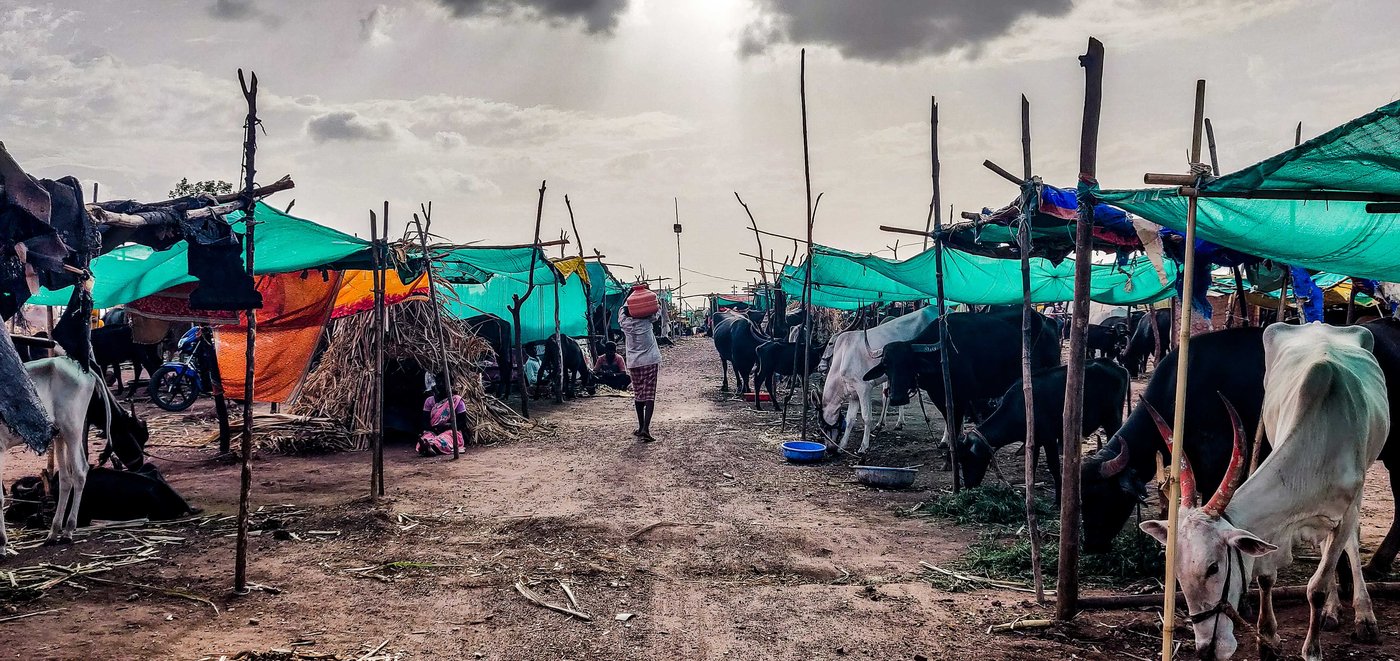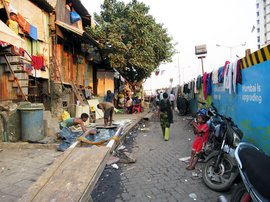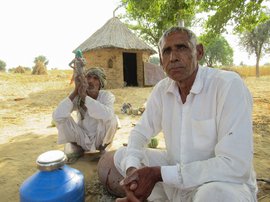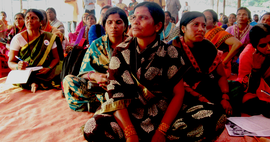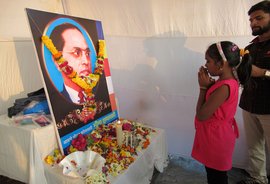This story is part of the PARI series on climate change that won the Ramnath Goenka Award for 2019 in the Environment Reporting category.
“People will call me crazy if I say this,” says 53-year-old Dnyanu Kharat, sitting on the mud floor of his brick house one afternoon. “But 30-40 years ago, during the rains, fish would flood our fields [from the nearby stream]. I caught them with my own hands.”
It’s mid-June and just a little while before we reach his house, a 5,000-litre water tanker has trundled into Kharat Wasti hamlet. Kharat, his wife Phulabai, and others in their joint family of 12 persons, are busy storing water in all available vessels, pots, cans and drums. The tanker has come after a week, the shortage of water is acute.
“You won’t believe, 50-60 years ago, we used to get such a heavy downpour, one could not keep the eyes open,” 75-year-old Gangubai Gulig tells us, sitting in the shade of neem trees near her house in Goudwadi, a village of around 3,200 people, some five kilometres from Kharat Wasti in Sangole taluka . “You saw those babool trees on your way here? That entire land produced excellent matki [mothbean]. The murum [basaltic rock] used to hold rainwater and springs would start from our fields. Just four rows of bajra in an acre would yield 4-5 sacks of grain [2-3 quintals]. The soil was that good.”
And Hausabai Aldar, who is in her 80s, remembers the twin wells on her family farm in Aldar Wasti, a hamlet not far from Goudwadi. “Both the wells would be full of water in the rainy season [around 60 years ago]. Each had two mote [a system of bull-drawn pulleys] and all four would run at the same time. Be it any time of the day or night, my father-in-law would draw water and give it to the needy. Now, one can’t even ask for a pot full. Everything has turned upside down.”
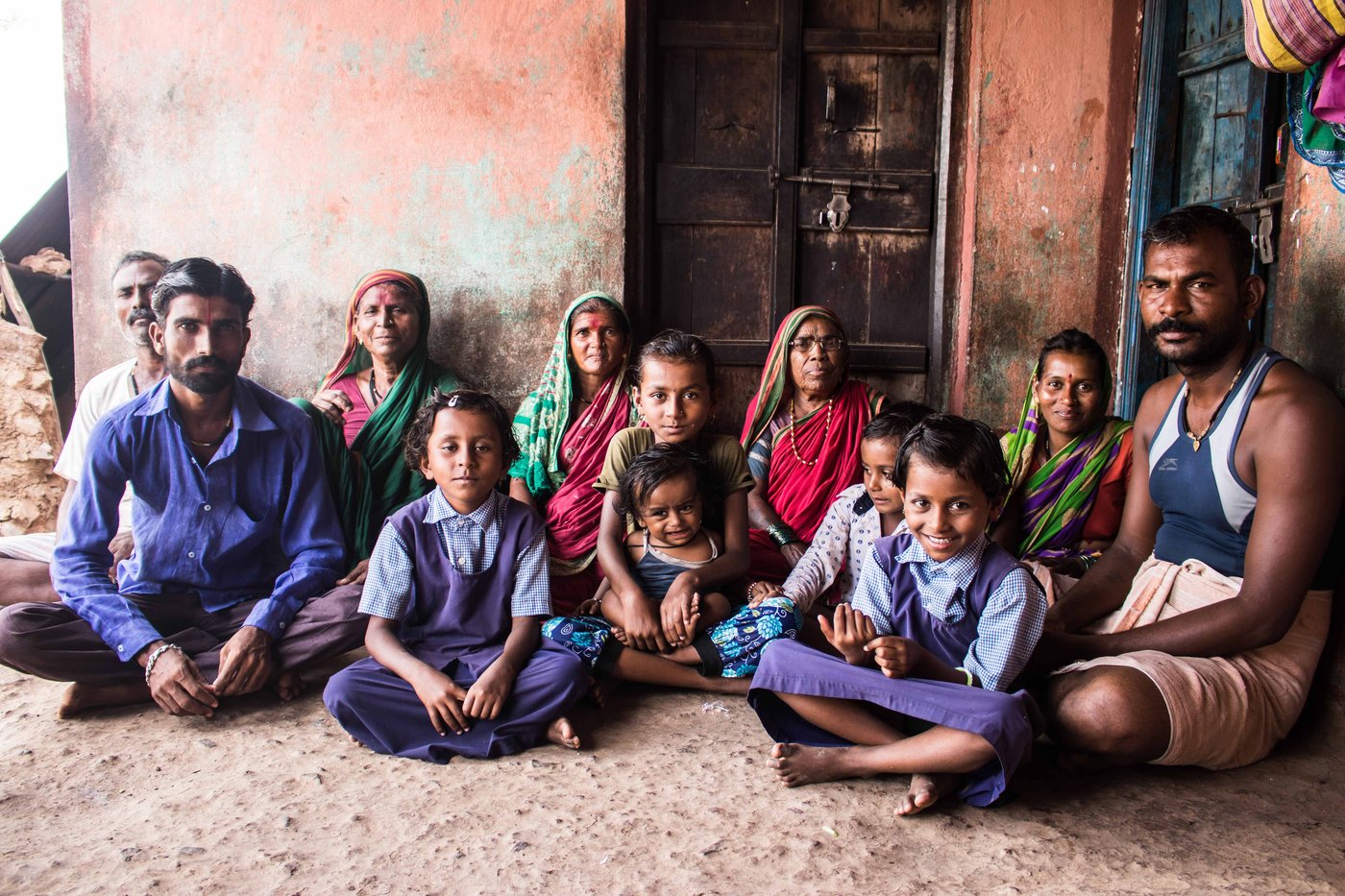
With the joint Kharat family, Dnyanu (far left) and Phulabai (to the left of the door): he remembers a time of fish floating in the fields
Sangole taluka in Maharashtra’s Solapur district is awash with such tales, even though it is located in Maandesh, a ‘rain shadow’ region (sheltered from rain-bearing winds by a mountain range). The region comprises Sangole (also commonly spelt as Sangola) and Malshiras talukas in Solapur district; Jat, Atpadi and Kavathemahankal talukas in Sangli district; and Man and Khatav talukas in Satara district.
Good rainfall and drought have for long been cyclical here, and memories of abundance are as embedded in people’s recollections as times of scarcity. But these villages are now brimming with stories of how “everything has turned upside down,” of how the abundance seems to be in the past, of how the old cyclical pattern has broken. So much so, that Nivrutti Shendge of Goudwadi says, “The rain has even stopped appearing in our dreams.”
“This land, where the camp is right now, was famous for its bajra . I too have cultivated it in the past…” says 83-year-old Vithoba Soma Gulig, fondly called Tatya, while preparing a paan for himself one blazing May afternoon at a cattle camp in Goudwadi. “Everything has changed now,” he adds, worried. “The rain has simply vanished from our village.”
Tatya, who is from the Dalit Holar community, has spent all his life in Goudwadi, as have 5-6 generations of his family before him. It’s been a hard life. For more than 60 years, he and his wife, Gangubai, migrated to Sangli and Kolhapur to cut sugarcane, laboured on people’s farms and worked on state-run sites in and around their village. “Our four-acre land was bought just 10-12 years ago. Till then, it was sheer hard labour,” he says.
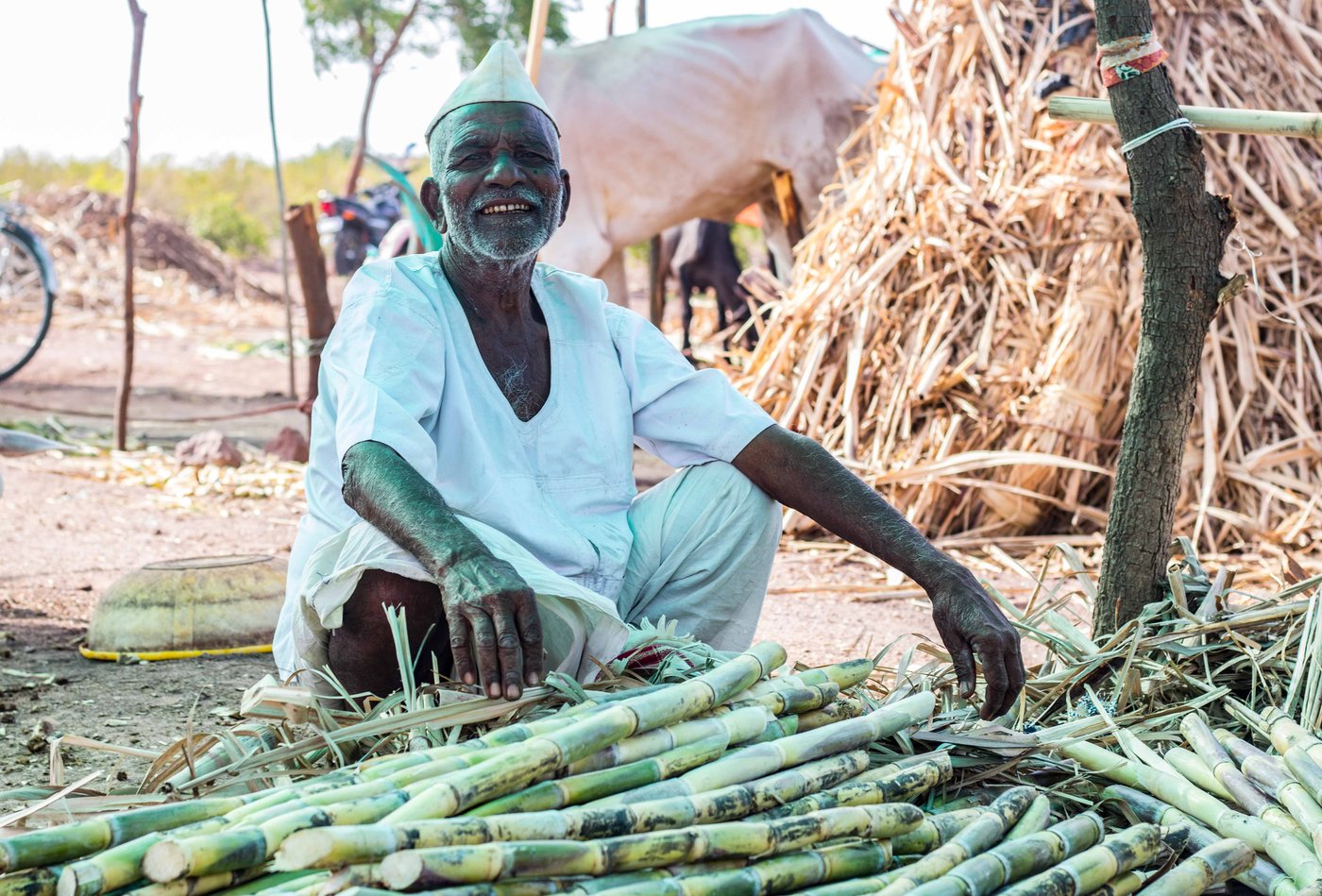
At a cattle camp in May near Goudwadi village, Vithoba Gulig or ‘Tatya’ says, ‘The rain has simply vanished from our village’
Now, though, Tatya is worried about the persistent drought in Maandesh. The natural cycle of good rain after a dry spell never returned to normal after 1972, he says. “It is less and less every year. We neither get [enough] waliw [pre-monsoon] showers nor the returning monsoon showers. And the heat is increasing day by day. Though last year [2018] we did get good waliw showers at least, this year... nothing till now. How will the land cool down?”
Many other elderly residents of Goudwadi recall the 1972 drought as a turning point in their village’s cyclical rhythms of rain and drought. That year, Solapur district received just 321 millimetres of rain (shows the indiawaterportal using India Meteorological Department data) – the lowest since 1901.
For Gangubai, memories of the 1972 drought are recollections of hard labour – even harder than her usual – and hunger. “We constructed roads, built wells, broke stones [during the drought, for wages]. The body had energy and the belly had hunger. I have worked for 12 annas [75 paise] grinding 100 quintals of wheat. Things only got worse after that [year],” she says.
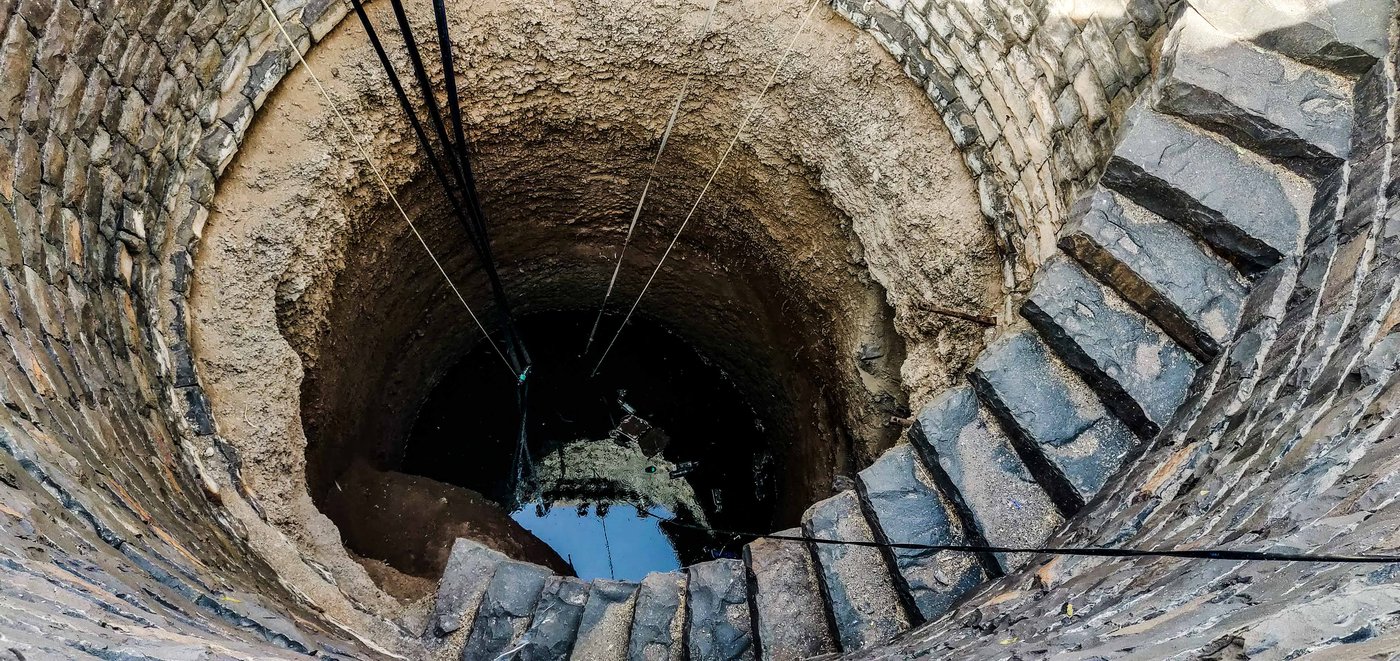
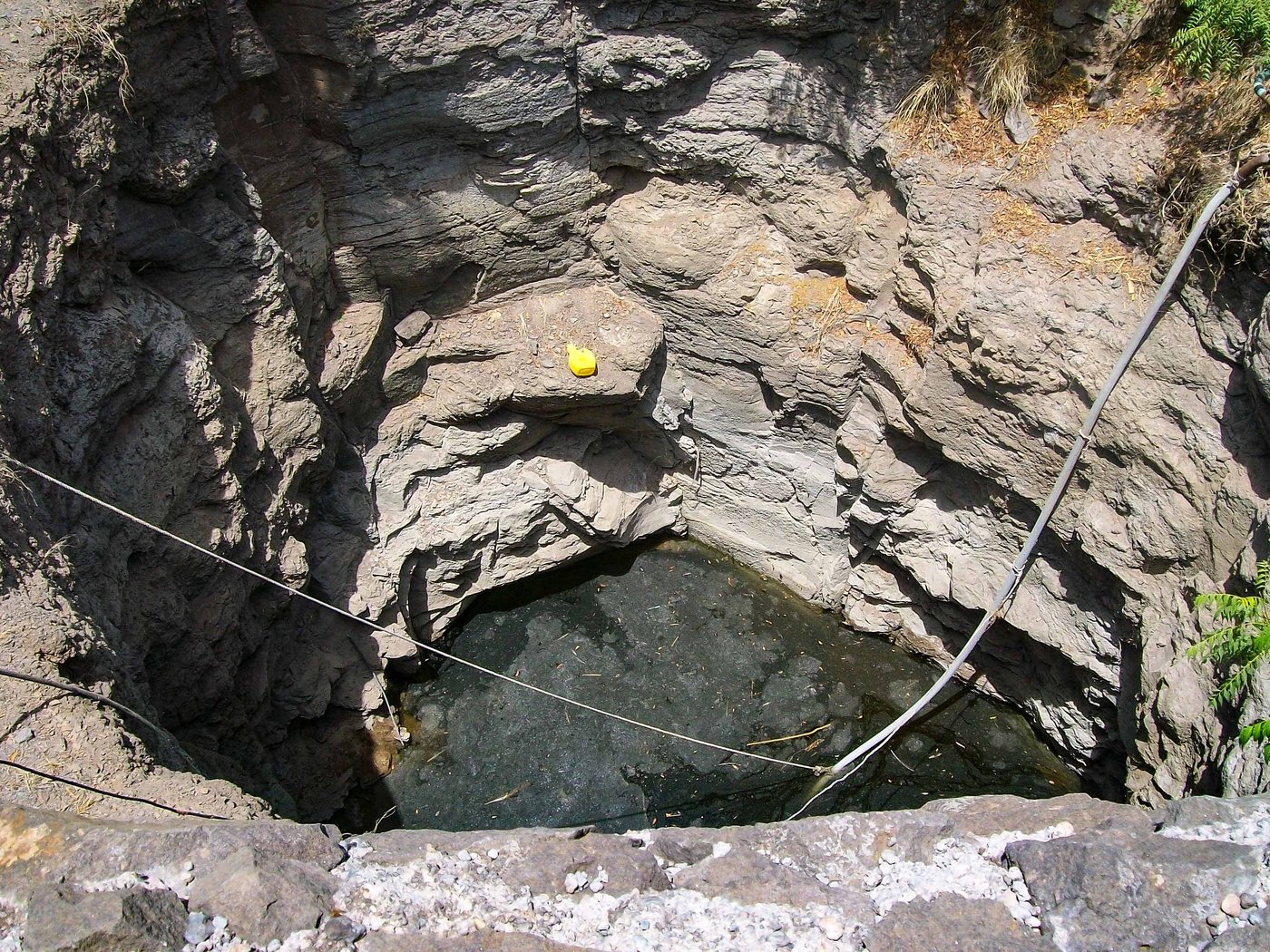
In 2018, Sangole received its lowest in 20 years and groundwater in the taluka’s villages fell by more than a metre
“The drought was so severe, I walked with my 12 cattle for 10 days and reached Kolhapur, all alone,” says 85-year-old Dada Gadade at the chai stall in the cattle camp. “The neem trees on Miraj road were all bare. All the leaves and shoots were fed to the cattle and sheep. Those were the worst days of my life. Nothing came back on track after that.”
The prolonged droughts even led to a demand, in 2005, of a separate district of Maandesh comprising all the drought-prone blocks carved out of the three districts of Solapur, Sangli and Satara. (The campaign eventually lost steam when some of its leaders shifted focus to issues such as irrigation schemes for the region).
Though it is the 1972 drought that many in Goudwadi recall as a milestone, data from the Solapur government website shows the district received even less rainfall in 2003 (278.7 mm) and in 2015 (251.18 mm).
And in 2018, Sangole received just 241.6 mm of rainfall, its lowest in 20 years, with only 24 rain days, says the ‘Rainfall Recording and Analysis’ portal of the Department of Agriculture, Maharashtra. A ‘normal’ rainfall for the block, the department notes, would be around 537 mm.
So the periods of water-abundance seem to have diminished or vanished, while the dry days, heat and months of water-scarcity are growing.
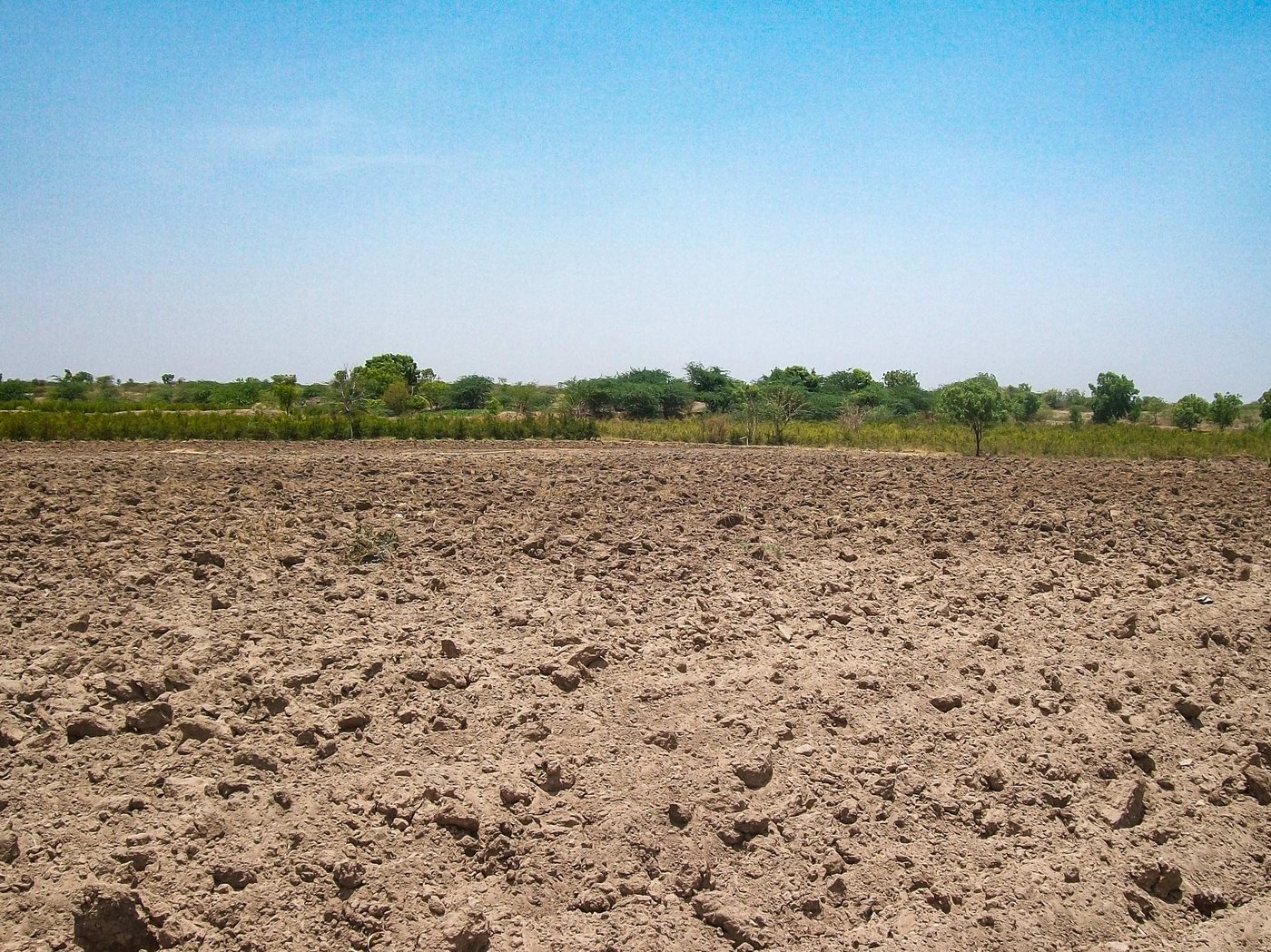
The loss of crop cover and growing heat have added to the soil's drying
In May this year, the temperature had reached 46 degrees at the cattle camp at Goudwadi. Extreme heat has added to the drying of the air and soil. Data from an interactive portal on climate and global warming of the New York Times shows that in 1960, when Tatya was 24 years old, Sangole saw 144 days where temperature could rise to 32 degrees Celsius. Today that number has increased to 177, and if he lives to be a 100, by the year 2036, it will reach 193 days.
Sitting in the cattle camp, Tatya recalls, “Earlier, everything happened on time. Mirig showers [with the arrival of the Mrug or Orion constellation] always came on June 7 and it rained so well that the waters from the Bhivghat [stream] lasted till Paush [January]. “When you sow on Rohini [constellation, around the end of May] and Mirig rains, the crop is protected by the skies. The grain is nutritious and one who eats such grain, is healthy. But the seasons are no longer the same.”
Other farmers sitting with him at the cattle camp agree. All are worried about the growing uncertainty of the rain. “Last year, the
panchaang
[the Hindu almanac based on the lunar calendar] said '
ghaveel
to
paveel'
– ‘who gets to sow on time, will reap a good yield’. But the rain is now sporadic, it will not cover all the fields,” explains Tatya.
Across the road, sitting at her tent in the camp, 50-year-old Phulabai Kharat from Kharat Wasti – she belongs to the Dhangar community (listed as a Nomadic Tribe), and has brought along three buffaloes – also reminisces about the “timely rain in all constellations.” She says, “Only with the arrival of Dhondyacha
mahina
[one extra month every three years in the Hindu lunar calendar], the rain would go quiet. The next two years we would get good rainfall. But for the last many years, the rain has been silent even otherwise.”
“Since the last 20 years, I have not come across any person in this village sowing [indigenous]
matki
. The same with
desi
varieties of
bajra
and
tur
. The
khapli
variety of wheat is no longer sown, neither
hulage
nor sesame,” says Hausabai of Aldar Wasti hamlet.
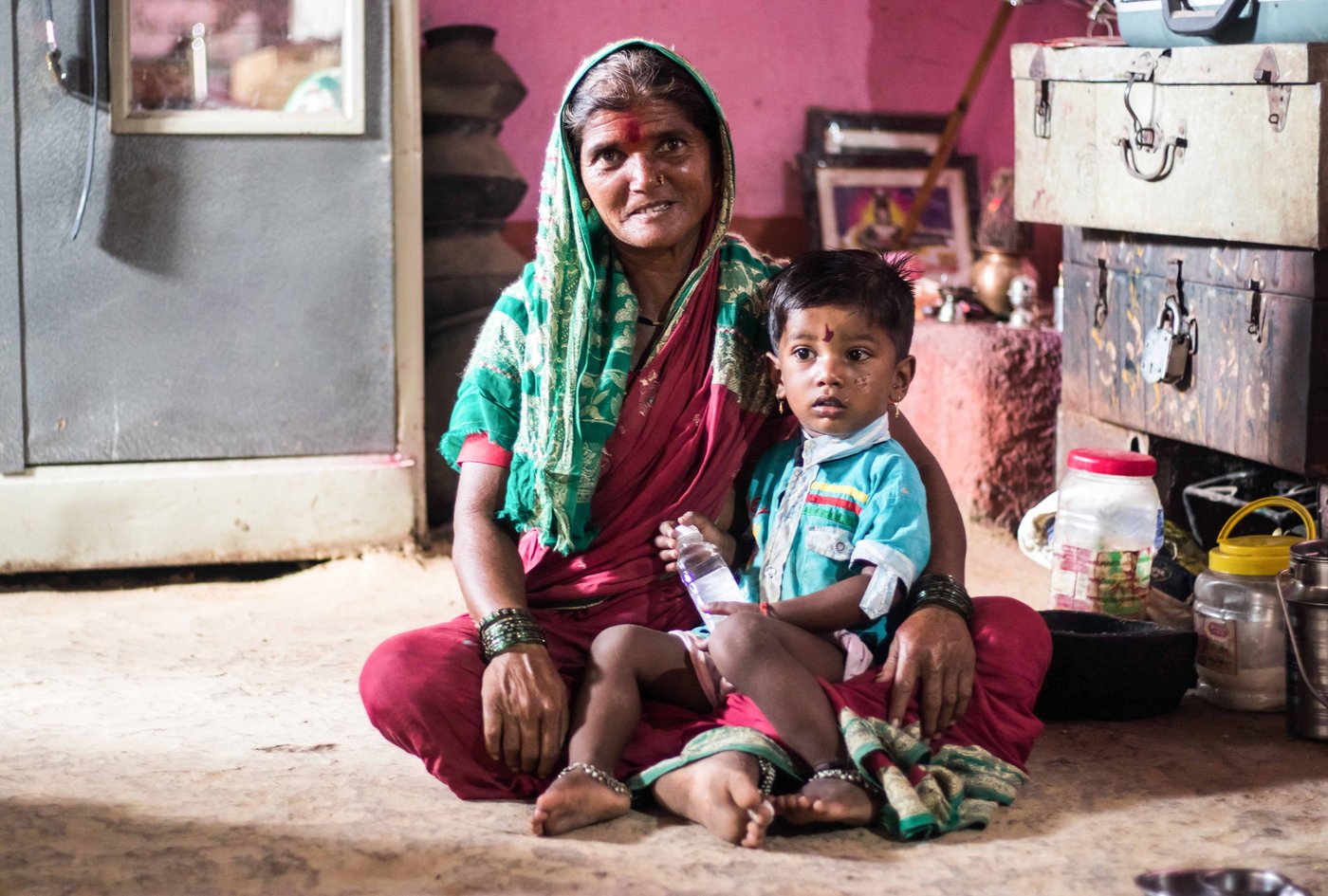
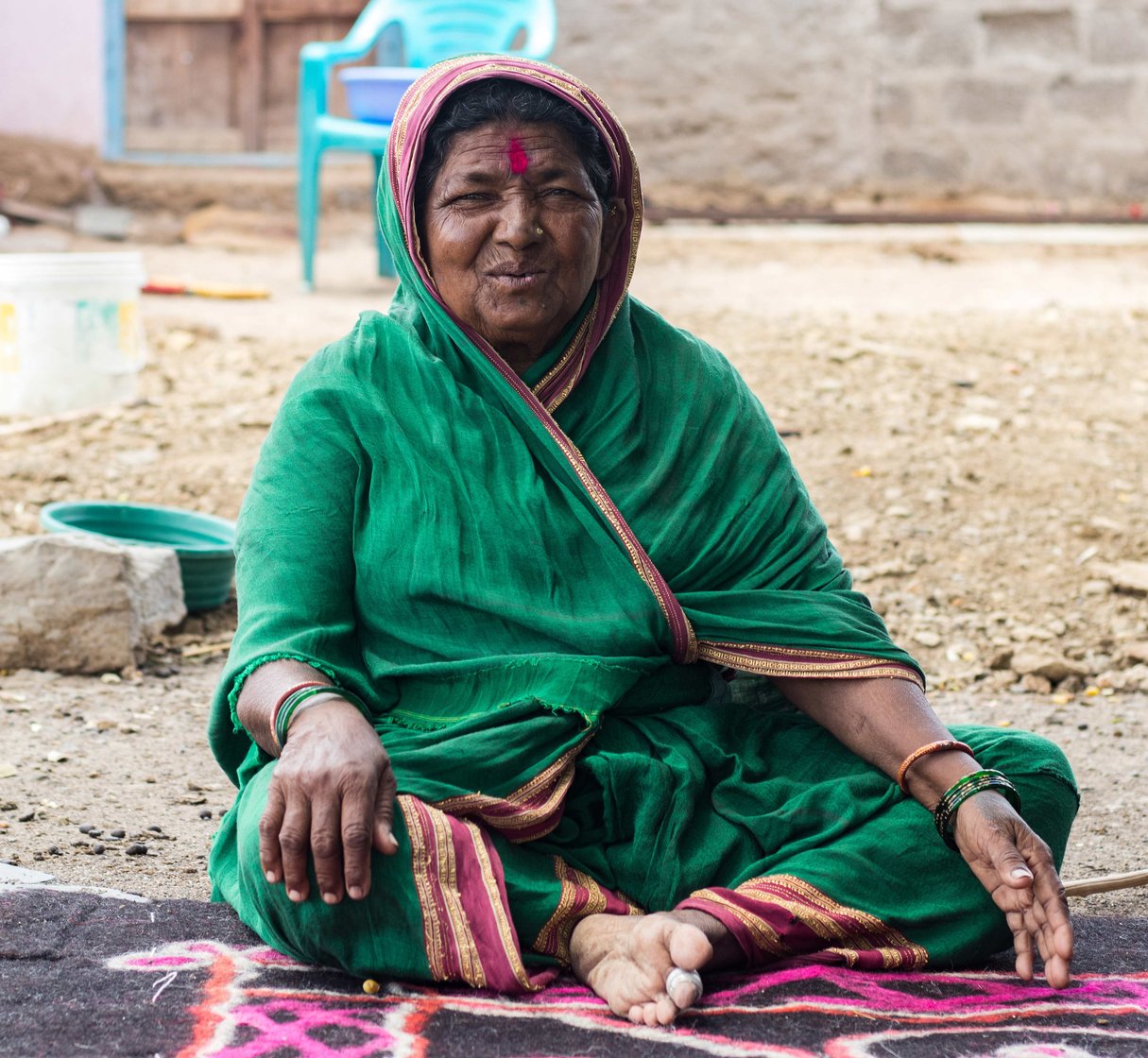
Left: Phulabai Kharat says, ‘But for last many years, the rain has been silent…’. Right: Gangubai Gulig says, ‘Things only got worse after 1972’
With the monsoon arriving late – by late June, even early July – and leaving early – September now barely sees any rain – farmers here are switching to shorter-duration hybrid varieties of crops. These require around 2.5 months from sowing to harvest. “The indigenous five-month [longer-duration] varieties of
bajra
,
matki
,
jowar
, and
tur
are close to becoming extinct as there is just not enough moisture in the soil,” says Navnath Mali. He, along with 20 other farmers from Goudwadi, is a member of the Amicus Agro group in Kolhapur which provides, for a fee, weather forecasts via SMS.
To try their luck with other crops, some farmers here shifted to cultivating pomegranate around 20 years ago. State subsidies helped. Over time, from
desi
varieties, the farmers shifted to hybrid, non-indigenous types. “We earned around 2-3 lakhs per acre in the beginning [around 12 years ago]. But over the last 8-10 years, the orchards are infested with
telya
[bacterial blight]. I feel this is due to the changing weather. Last year, we had to sell our fruit at 25-30 rupees a kilo. What can we do about the whims of nature?” asks Mali.
The cropping patterns have also been greatly impacted by changes in the pre and post monsoon showers. The post monsoon rainfall – from October to December – in Sangole has perceptibly decreased. In 2018, the block received just 37.5 mm of post monsoon rain, Department of Agriculture data show, against an average of 93.11 mm for a two-decade period from 1998 to 2018.
“The most worrisome trend for the entire Maandesh region is the disappearance of the pre and post monsoon showers,” says Chetna Sinha, founder of Mann Deshi Foundation, which works with rural women on issues of farming, credit and enterprise. (The foundation started the first cattle camp in the state this year, on January 1, in Mhaswad in Man block of Satara district, which sheltered more than 8,000 cattle). “The returning monsoon has been our lifeline as we depend on rabi crops for foodgrain and fodder for livestock. The absence of the returning monsoon since 10 or more years has had far-reaching impacts on pastoral and other communities in Maandesh.”
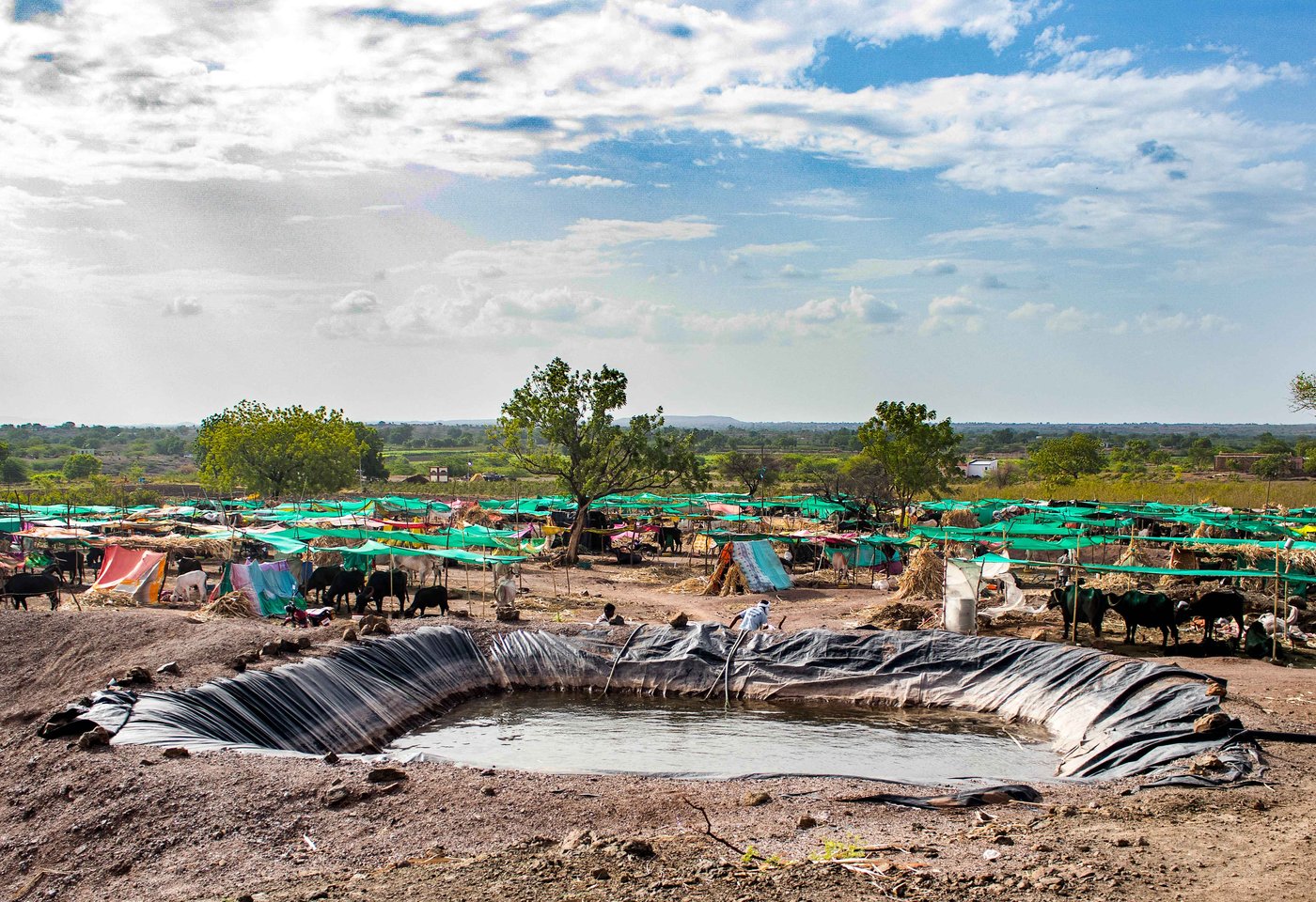
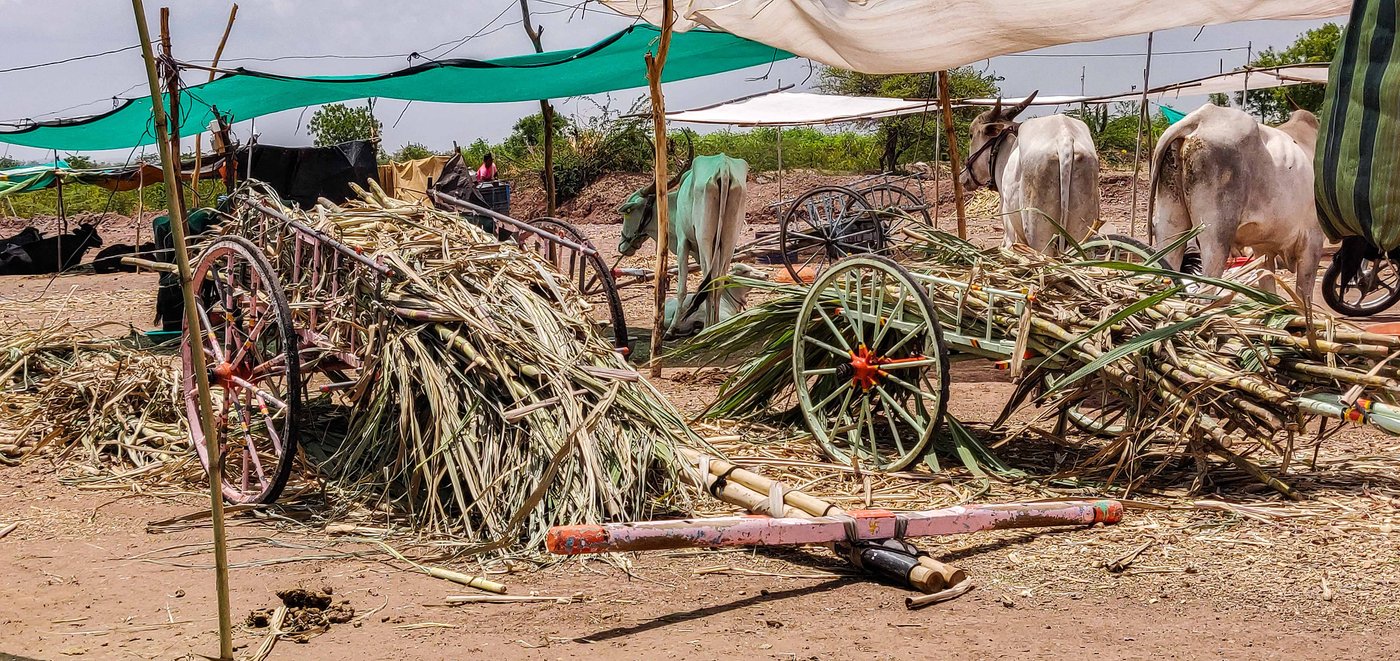
The scarcity of fodder has given rise to cattle camps in the dry months in Sangole
But perhaps the biggest change in cultivation practices here is the spread of sugarcane. In 2016-17, Solapur district cultivated 633,000 tons of sugarcane on 100,505 hectares of land, says data of the Finance and Statistical Directorate, government of Maharashtra. According to some news reports, by January this year, Solapur was at the top in the sugarcane crushing season that started in October, with more than 10 million tons crushed by 33 registered sugar mills (Sugar Commissionerate data) in the district.
Crushing just one ton of sugarcane, says Rajneesh Joshi, a Solapur-based journalist and water conservation activist, requires around 1,500 litres of water. This means that in the last sugarcane crushing season – October 2018 to January 2019 – over 15 million cubic metres of water were used for sugarcane in Solapur district alone.
With this gigantic use of water on one cash crop, the water available for other crops drops even more drastically in a region already struggling with low rainfall and a lack of irrigation. In Goudwadi, a village located on 1,361 hectares (Census 2011), most of it under cultivation, only 300 hectares are irrigated, estimates Navnath Mali – the rest is rain-fed. In Solapur district, government data show, of the total irrigation potential of 774,315 hectares, only 39.49 per cent was irrigated in 2015.
And the loss of crop cover (due to the switch to shorter-duration crops as a way to cope with the decreasing rain) as well as the growing heat, the farmers say, has further dried up the soil. The moisture in the soil now “is not even six-inches deep,” says Hausabai.
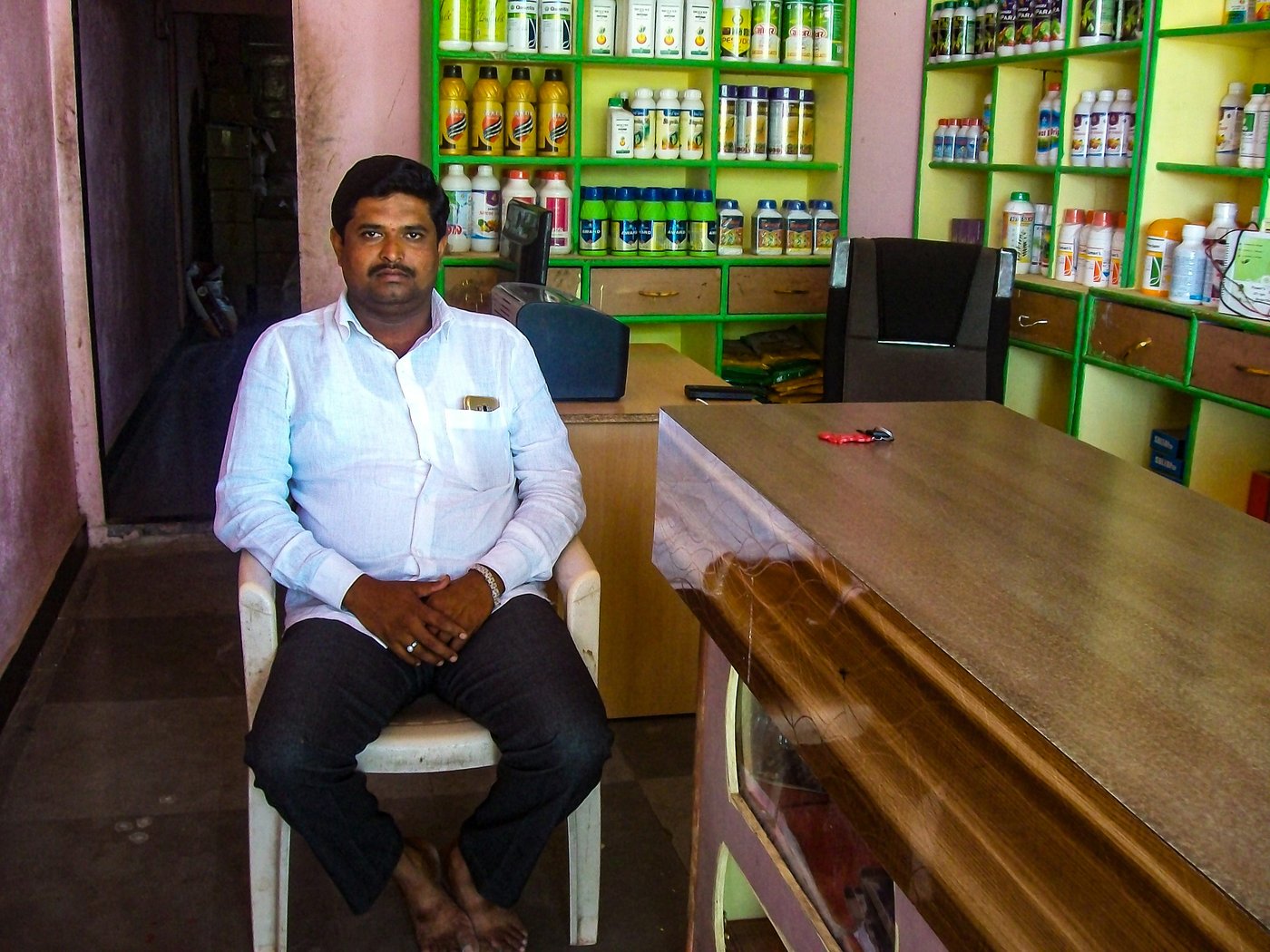
Navnath Mali estimates that in just Goudwadi, there are 150 private borewells, of which at least 130 have dried up
Groundwater levels are dropping too. The Probable Water Scarcity Report of the Groundwater Surveys and Development Agency shows that in 2018, in all 102 villages of Sangole, groundwater fell by more than a metre. “I tried drilling a borewell, but even at 750 feet, there is no water. The land is completely dry,” says Jotiram Khandagale, who owns around four acres and also runs a hair-cutting stall in Goudwadi. “Since the last few years, there is no guarantee of a good yield in both kharif and rabi seasons,” he adds. Mali estimates that in just Goudwadi, there are 150 private borewells, of which at least 130 have dried up – and people are digging even up to 1,000 feet to reach water.
The massive shift to sugarcane has also added to the move away from food crops. In the 2018-19 rabi season, Solapur district recorded only 41 per cent of jowar and 46 per cent of maize cultivation, says the Department of Agriculture. Across Maharashtra, the area on which jowar is cultivated has reduced by 57 per cent, and maize by 65 per cent, says the state’s Economic Survey 2018-19 . And the yields of both crops have dropped by around 70 per cent.
Both crops are a critical source of foodgrain for humans and fodder for livestock. The scarcity of fodder has compelled the government (and others) to start cattle camps in the dry months in Sangole – as many as 105 camps with close to 50,000 cattle so far in 2019, estimates Popat Gadade. He is the director of a milk cooperative and the man who started the cattle camp in Goudwadi. And what do the cattle eat in these camps? The same sugarcane that guzzles (as estimates show) 29.7 million litres of water per hectare.
So, many intertwined shifts are underway in Sangole, those that are part of ‘nature’, but more so, those set in motion by humans. Among these are decreasing rainfall, fewer rain days, rising temperatures, more days of extreme heat, near-absent pre and post monsoon showers, and moisture loss in soil. As well as changes in cropping patterns — more shorter duration varieties and the resultant loss of crop cover, fewer desi varieties, cultivation of fewer food crops such as jowar and more cash crops like sugarcane – along with poor irrigation, depleted groundwater levels – and more.
When asked what’s causing all these changes, Tatya at the Goudwadi cattle camp, smiles and says, “If only we could read the mind of the rain god! When man has become greedy, how will it rain? When human beings have changed their ways, how will nature follow its own?”
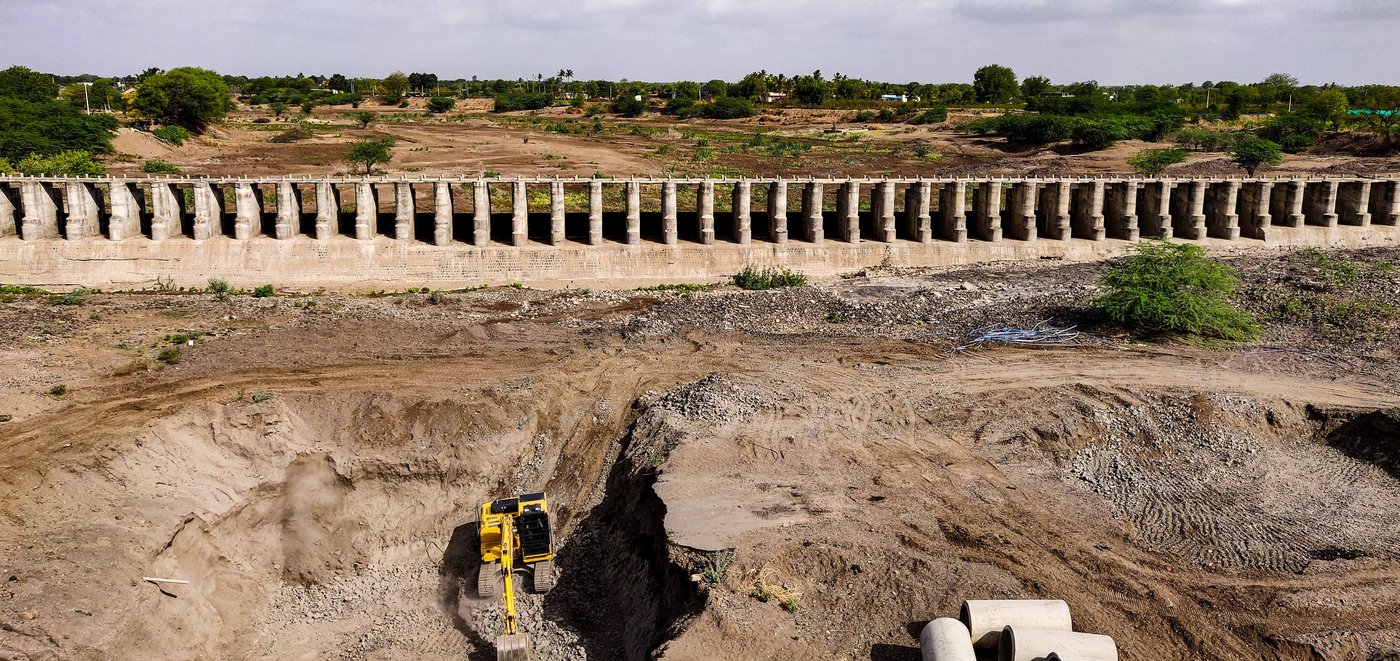
The old barrage on the dried up Man river just outside Sangole city
The author would like to thank activists Shahaji Gadahire and Datta Gulig for their time and valuable inputs.
Cover photo: Sanket Jain/PARI
PARI’s nationwide reporting project on climate change is part of a UNDP-supported initiative to capture that phenomenon through the voices and lived experience of ordinary people.
Want to republish this article? Please write to [email protected] with a cc to [email protected]
